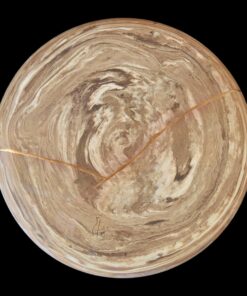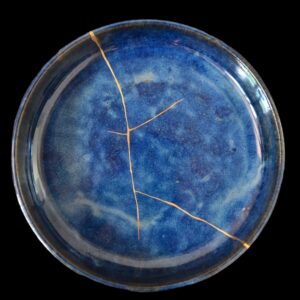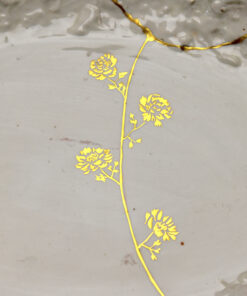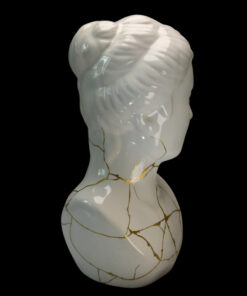The Art of Scarred Perfection: Unveiling the World of Kintsugi
What the word Kintsugi means ?
Kin-tsugi, which literally translates to “joining with gold”, is a beautiful and symbolic Japanese art form used to repair broken pottery. It involves mending the cracks and broken pieces with a japanese lacquer sprinkled with pure gold powder.
When silver powder is used, we speak of Gin-tsugi, and for tin, Tin-tsugi.
What is the difference between Kintsugi and Kintsukuroi ?
While often interchangeably used, there’s a subtle difference between “kintsugi” and “kintsukuroi”:
Similarities:
- Both refer to the Japanese art of repairing broken pottery with gold-dusted lacquer.
- The technique involves mending the cracks with a special adhesive made from urushi lacquer, often sprinkled with powdered gold, silver, or platinum.
- The repaired object becomes stronger and more beautiful, highlighting its history and imperfections.
Differences:
- Meaning:
- “Kintsugi” literally translates to “golden joinery,” emphasizing the joining of broken pieces.
- “Kintsukuroi” translates to “golden repair,” focusing more on the act of mending itself.
- Focus:
- “Kintsugi” emphasizes the aesthetic aspect, highlighting the mended cracks as part of the object’s beauty.
- “Kintsukuroi” emphasizes the functional aspect, ensuring the repaired object is usable again.
In essence, both terms describe the same technique, but “kintsugi” leans towards the artistic and aesthetic side, while “kintsukuroi” leans towards the practical and functional side.
Where and when Kintsugi was created ?
The exact origins of kintsugi are shrouded in a bit of mystery, but the most common story attributes its creation to a specific person and event:
Ashikaga Yoshimasa, the 8th shogun of the Ashikaga shogunate in 15th century Japan, is often credited with sparking the development of kintsugi. According to legend, he sent his favorite tea bowl, which had cracked, back to China for repair. The bowl was returned fixed, but the repair was crude and unsightly, using metal staples. Displeased, Yoshimasa challenged Japanese artisans to find a more aesthetically pleasing way to mend pottery. This led to the development of kintsugi, the art of repairing broken ceramics with gold lacquer, highlighting the cracks rather than hiding them.
It’s important to note that this is just one story, and the true origins of kintsugi might be more complex. Some believe the technique might have existed earlier in Japan or even other cultures, with Yoshimasa’s involvement marking a key refinement or popularization.
Regardless of its precise origins, kintsugi has become a cherished art form and philosophy, celebrating the beauty of imperfection and resilience.
Dishes and plates
Dishes and plates
Dishes and plates
Extraordinary Kintsugi







